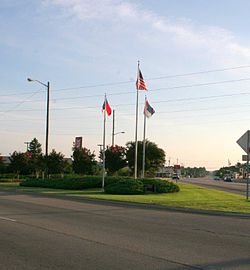Spring Lake, North Carolina | |
|---|---|
 Intersection with North Bragg Boulevard and Lillington Highway in Spring Lake | |
| Motto: "Unity for Prosperity" [1] | |
 Location in Cumberland County and the state of North Carolina. | |
| Coordinates: 35°11′04″N78°59′46″W / 35.18444°N 78.99611°W | |
| Country | United States |
| State | North Carolina |
| County | Cumberland |
| Government | |
| • Type | Council-Manager |
| • Current mayor | Kia Anthony [2] |
| • First mayor | Grady Howard |
| Area | |
• Total | 23.84 sq mi (61.74 km2) |
| • Land | 23.62 sq mi (61.18 km2) |
| • Water | 0.22 sq mi (0.56 km2) |
| Elevation | 171 ft (52 m) |
| Population (2020) | |
• Total | 11,660 |
| • Density | 493.65/sq mi (190.60/km2) |
| Time zone | UTC-5 (Eastern (EST)) |
| • Summer (DST) | UTC-4 (EDT) |
| ZIP code | 28390 |
| Area codes | 910, 472 |
| FIPS code | 37-64180 [5] |
| GNIS feature ID | 2407386 [4] |
| Website | www |
Spring Lake is a town in Cumberland County, North Carolina, United States. The 2010 census recorded the population at 11,964 people, [6] with an estimated population in 2019 of 12,005. [7]


